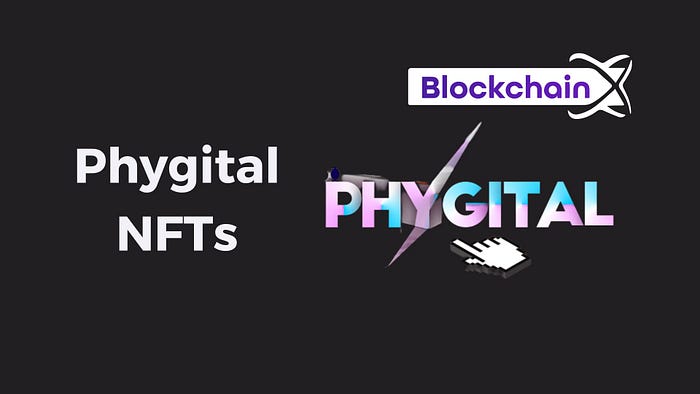What are phygital NFTs?
Phygital NFTs, short for “physical-digital NFTs,” refer to a concept that combines physical objects with digital ownership through non-fungible tokens (NFTs). They bridge the gap between the physical and digital realms by integrating tangible items with blockchain-based digital tokens. Phygital NFTs enable verifiable proof of ownership, authenticity, and scarcity for physical objects in the digital world.

Here’s how phygital NFTs typically work:
- Physical Object: A physical item, such as artwork, collectibles, fashion items, or even real estate, is created or produced.
- Tokenization: The ownership or authenticity of the physical object is represented by a unique NFT. The NFT is minted on a blockchain, such as Ethereum, and contains metadata that describes the physical object, including its characteristics, provenance, and other relevant details.
- Digital Representation: The NFT serves as a digital representation or certificate of ownership for the physical object. It contains a unique identifier that links it to the specific physical item, ensuring its uniqueness and immutability on the blockchain.
- Ownership and Transfer: The NFT can be bought, sold, and traded on NFT marketplaces or platforms. When ownership of the NFT changes hands, it signifies the transfer of ownership of the underlying physical object. The transaction history and ownership records are transparently stored on the blockchain.
- Digital Interactions: Phygital NFTs often come with additional digital interactions or experiences. These may include exclusive content, augmented reality (AR) or virtual reality (VR) experiences, unlockable digital assets, or access to events or communities related to the physical object.
The combination of physical and digital elements in phygital NFTs offers several advantages. It provides a transparent and immutable record of ownership, reduces the risk of counterfeit items, enables fractional ownership, and enhances the value and collectability of physical objects by connecting them to the digital world.
The combination of physical and digital elements in phygital NFTs offers several advantages. It provides a transparent and immutable record of ownership, reduces the risk of counterfeit items, enables fractional ownership, and enhances the value and collectability of physical objects by connecting them to the digital world.
The benefits of phygital NFTs
Phygital NFTs, which combine physical objects with digital ownership through non-fungible tokens (NFTs), offer several benefits. Here are some key advantages of phygital NFTs:
- Verifiable Ownership and Authenticity: Phygital NFT provide verifiable proof of ownership and authenticity for physical objects. The blockchain technology used in NFTs ensures transparency and immutability, reducing the risk of counterfeit goods and fraud. Buyers can have confidence in the origin and legitimacy of the physical item.
- Fractional Ownership: NFTs enable fractional ownership, allowing multiple individuals to own a fraction of the physical object. Fractional ownership can make high-value or rare items more accessible, as people can invest in a portion of the object rather than having to purchase the entire item.
- Increased Value and Collectability: By tokenizing a physical object as an NFT, its value and collectability can be enhanced. The digital ownership and associated metadata can add an additional layer of uniqueness, historical data, and provenance to the item. Collectors and enthusiasts are often attracted to the scarcity and digital representation of the physical object.
- Digital Interactions and Experiences: Phygital NFTs often come with digital interactions and experiences that enrich the ownership and engagement with the physical item. This can include access to exclusive content, augmented reality (AR) or virtual reality (VR) experiences, unlockable digital assets, or participation in digital communities related to the object. These digital elements can enhance the overall value proposition of the physical object.
- Global Marketplace and Accessibility: NFT marketplaces provide a global platform for buying, selling, and trading phygital NFTs. This expands the reach and accessibility of physical objects, allowing collectors and enthusiasts from around the world to participate. Digital ownership also simplifies the process of transferring ownership, as it can be done electronically, eliminating the need for physical shipping or logistics.
- Potential Royalties and Secondary Sales: NFTs can be programmed with smart contracts, enabling artists or creators to receive royalties or commissions from secondary sales. This means that if the physical object is resold in the future, the original creator can receive a percentage of the sale price, providing ongoing revenue opportunities.
- Preservation and Digitization: Phygital NFTs offer a means to preserve and digitize physical objects. By creating a digital representation of the object, its characteristics, and provenance can be recorded and stored securely on the blockchain. This can be particularly valuable for historical artifacts, rare collectibles, or fragile items that may deteriorate over time.
These benefits contribute to the growing interest and adoption of phygital NFTs across various industries, including art, fashion, sports memorabilia, and more. However, it’s important to note that the value and success of phygital NFTs also depend on factors such as market demand, quality of the physical object, and the overall user experience associated with the digital components.
It’s worth noting that the specific implementation of phygital NFTs can vary across different projects or platforms. Each initiative may have its own unique features, authentication processes, and digital experiences associated with the physical object.

